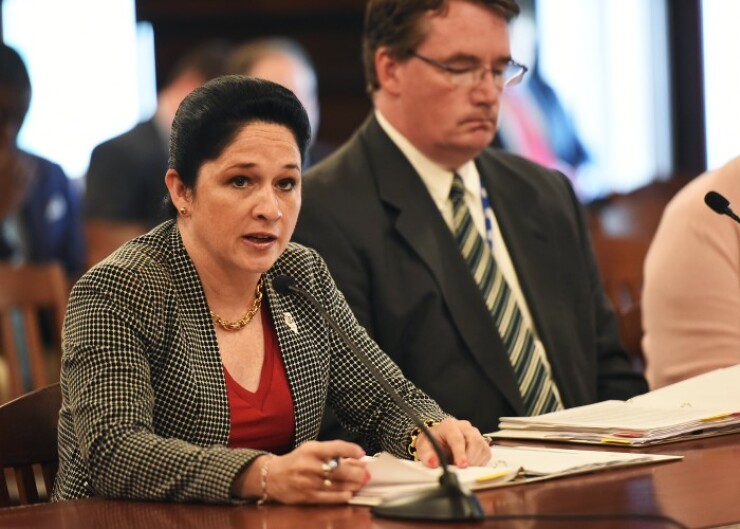Illinois’ tally of overdue bills hit a years-long low of $3.5 billion this week, state Comptroller Susana Mendoza told rating agencies in a fiscal update as the state awaits an infusion of federal dollars next month.
The tab’s size — scrutinized by rating agencies and investors as a sign of the state’s liquidity health — marks a turnaround from the $16.7 billion high it hit in November 2017 as bills mounted from the state’s two-year long budget impasse.
The new low comes at state spreads in secondary market trading have shrunk to around 90 basis points to the Refinitiv MMD’s AAA 10-year benchmark, a level not seen since before the 2016-2017 budget impasse.
The state’s rating remains one cut away from junk over its chronic $141 billion pension liability and structural imbalance but Moody’s Investors Service and S&P Global Ratings recently moved their
The
“The oldest commercial voucher date for payments to vendors and providers of state goods and services is now only April 26, 2021” and what remains of the backlog is due to funds owed to state agencies, group health insurance payments, and invoices not yet received by the comptroller, Mendoza writes to rating agencies.

In 2017, the state was behind up to a year in payments owed to vendors like nursing homes and hospice centers. Medicaid providers took the state to court in the spring of 2017 to demand payment in litigation that threatened the state’s investment grade status.
A handful of Republicans joined the legislature’s Democratic majority to pass a budget and income tax hike in July 2017 staving off a rating cut to junk. Lawmakers also overrode then Gov. Bruce Rauner’s veto. Rauner, a Republican, lost the 2018 election to J.B. Pritzker, a Democrat. Mendoza is also a Democrat, who ousted the Republican incumbent from office in 2016.
In the fall of 2017, the state borrowed $6 billion to bring the backlog down and an income tax hike also contributed to a steady decline to $6.8 billion at the start of fiscal 2019 on July 1, 2018. It hovered between $6 billion and $7 billion through 2019.
While the state was at risk of build-up due to COVID-19 pandemic strains on tax revenues, the state’s borrowing through the Federal Reserve’s Municipal Liquidity Facility helped instead chip away it and the comptroller used the funds to leverage additional Medicaid matching dollars.
The state began fiscal 2021 on July 1, 2020 with the tab at $5.4 billion. The backlog was down to $5 billion at the start of 2021 and it’s dropped sharply over the last four months.
Rosier than expected tax collections and an infusion of April income tax payments have helped despite the state’s extension of the filing deadline to May 17. “It appears many filers may have stuck with the April 15 deadline,” Mendoza said.
The goal is to bring the backlog down about $3 billion based on the state’s roughly $42 billion general fund budget as that level would represent a 30-day payment cycle common in private industry.
The state could reach that level if it dedicates a portion of the looming infusion of $7.5 billion of federal relief from the American Rescue Plan to pay down some of the tab in addition to paying off the MLF and other short-term borrowing.
“Depending on federal guidance, I’ve been a strong advocate, as has Gov. Pritzker, of strategically applying the estimated $3.75 billion in federal ARP monies coming to Illinois next month toward paying down these COVID loans,” Mendoza wrote to the rating agencies in the April 28 letter. The state expects another $3.75 billion the following year under terms of the ARP.
The state owes $1.043 billion borrowed from non-general funds, $400 million using the State Treasurer's Office's investment tool and $2.175 billion in MLF loans. The state took out from the MLF a $1.2 billion, one-year loan last spring to manage the 2020 budget shortfall and returned for a $2 billion, three-year loan last December for the fiscal 2021 budget.
Lawmakers continue to hash out a fiscal 2022 budget ahead of an end-of-May deadline. Both Democrats and Republicans have pushed back against some of the $900 million corporate tax loopholes Pritzker has proposed ending. Opponents argue they are not needed given the federal relief and that they could harm the economy.
State Budget Director Alexis Sturm pushed back stressing that a new, recurring source of revenue is needed to address the state’s structural budget gap. “Illinois has struggled with a persistent budget deficit for the last few years … these are changes more permanent in nature that would go to try to address some of the underlying structural challenges of the state's budget,” Sturm told lawmakers during a legislative hearing.
Local governments have pushed back against the potential loss of about $150 million in income tax revenue the state shares with local governments due to a proposed 10% cut in Pritzker’s budget plan. The administration has countered that local governments stand to gain more money — nearly $230 million — by ending the corporate tax loopholes and should get behind that proposal.
Recent reports have backed up Sturm’s warning over the need to solve the
The state’s structural balance has weighed on the balance sheet for at least two decades and a fix is needed, the University of Illinois' Institute of Government and Public Affairs wrote in a
“Structural change in our revenue system and revenue increases have to be part of the equation if Illinois is to have a structurally balanced budget,” said David Merriman, director of the project.
The report recommends creation of a nonpartisan, objective state tax commission comprised of experts who operate independently of elected officials to draft a menu of potential changes to the tax system that would meet their revenue, equity and economic goals.





